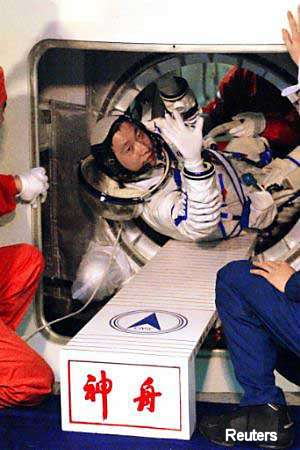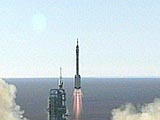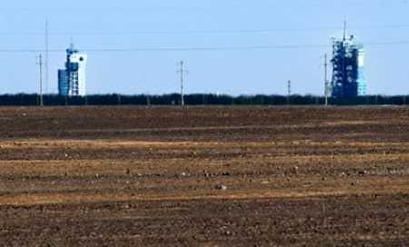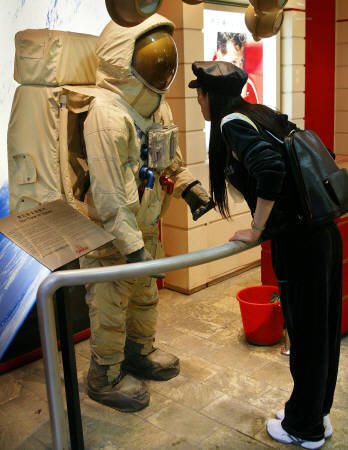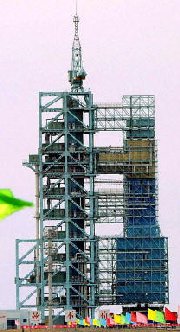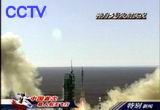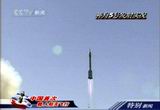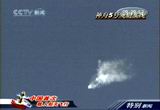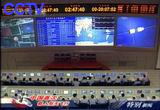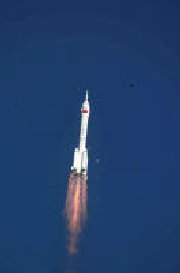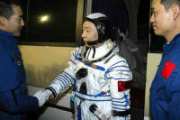2003-10-15 中国が初の有人宇宙船打ち上げ成功



中国初の有人宇宙船「神舟(しんしゅう)5号」が15日午前9時(日本時間同10時)、同国西部の甘粛省・酒泉衛星発射センターから打ち上げられ、予定された軌道に乗った。有人宇宙船の打ち上げは旧ソ連、米国が1961年に相次いで成功させて以来で、3か国目。
香港紙などによると、打ち上げには国産の長征2号Fロケットを使用。「神舟5号」の船体は、最大直径約2・8メートル、重さ約7・5トン。軌道周回部、地上帰還部、推進エンジン部の三層構造で、飛行士の乗る釣り鐘型の帰還部分(長さ約2・1メートル)は、地球を14周した後、打ち上げ翌日に内モンゴル自治区へ着陸する予定だ。
(編集者から:宇宙飛行士の名前は、Yang Liwei, 38歳で、人民解放軍中佐である。1983年以来空軍パイロットを務める。三人の最終選考から選ばれた。この数日間はシェンゾウ5宇宙カプセル内で操縦と試験を行っていた。主には緊急事態が発生した場合の緊急避難訓練であった。)
2003-10-15 China launches its first manned spacecraft
China's first manned spacecraft, the Shenzhou-5, blasted off from the Jiuquan SatelliteLaunch Center in the northwestern province of Gansu at 9 a.m. Wednesday. The spacecraft, atop a Long March II F rocket, was piloted by Yang Liwei, 38, a lieutenant colonel of the People's Liberation Army (PLA).
China successfully launched its first manned spacecraft "Shenzhou V" from Jiuquan Satellite Launch Center and sent its first astronaut to the space with "Long March CZ-2 F" carrier rocket at 9:00 am Beijing Time October 15, and later the spacecraft entered its orbit. This is China's first manned spaceflight, which marked the breakthrough of China's manned space project. China has become the third country in the world, which can independently carry out the manned space activities.
At 9:10 am, Shenzhou V entered precisely into its pre-set orbit. State leaders Hu Jintao, Huang Ju, Wu Guanzheng, Cao Gangchuan and Wang Gang watched the launch at the launching site.
Shenzhou V, the manned spacecraft, is mainly developed by Chinese Academy of Space Technology (CAST) and Shanghai Academy of Space Navigation, which are subordinated to China Aerospace Science & Technology Corporation (CASC). The spacecraft consists of several such modules as propelling, returning and orbit and an attachment module as well. The spacecraft can carry three astronauts and possesses the functions of the emergency return from the orbit or controlled by hand.
The "Long March CZ-2 F" carrier rocket, which carried "Shenzhou V" into the orbit, is developed mainly by China Academy of Launch Vehicle Technology (CALT) which is a subsidiary to CASC. This rocket is a kind of clustered carrier with enormous propelling power developed for the project of China's manned spacecraft, which has succeeded in five launches in succession since Shenzhou I was sent into the space.
The launching pad for manned spacecraft is the new type of installment for the launch of spacecraft developed in China's "Ninth Five Year Plan" period, which is equipped with vertical assembling, vertical testing, vertical operation mode, long distance testing and launching control.
The application system for manned spaceflight will carry out scientific and technological experiments in the manned spacecraft
Department under Chinese Academy of Science and Ministry of Information Industry have developed the apparatuses to be carried in the spacecraft for scientific experiments and application in the space and the cybernetic facilities on the ground.
Several emergency life-saving spots on land and on the sea have been set up for the manned spaceflight this time.
During the period when the spacecraft was flying in the orbit, the monitor and commanding centers under Xi'an Satellite Monitor & Control Center and "Yuanwang" vessel for space surveying will keep on monitoring, surveying and controlling the spacecraft under the united management and directions from Beijing Space Direction & Control Center. The health, living and working conditions of the astronaut can be known by way of the physiological parameters and the images and voices remote-senses and transmitted back to the earth.
It was the 71st flight of "Long March" series rockets, and also the 29th successful launch in succession for spaceflight in China since October 1996.
By People's Daily Online



